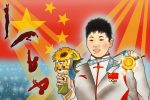The Shen Yun posters are everywhere. To understand their ubiquity on this planet, think of them as atoms in matter. Think of oxygen in the air or pieces of plastic floating in the ocean. Turn any corner in just about any city within probable proximity to a theater or performing arts center and you will be greeted by the image of a performer dressed in flowing traditional Chinese garb captured mid-air. From small towns to bustling metropolises, the posters all shout the same message: When Shen Yun is coming to your area, it will be impossible to ignore.
The posters offer a pleasant if neutered premise. A dance troupe that trains and specializes in traditional Chinese styles, their performances are marketed as showstoppers imported straight from the culturally rich shores of one of the world’s largest superpowers.
But the show is also shrunken down to accommodate its seemingly endless touring schedule and the variety of venues it stops in. Shen Yun offers centuries of history abridged. It is a few hours of culturally tinged if ultimately forgettable spectacle. It is fun for the whole family.
Essentially, there is hardly anything to actively dislike about this affable dance troupe. So why, then, is the Chinese government so scared of Shen Yun?
Shen Yun’s past is not a secret. Like an optical illusion or a trap door, its mysteries can be revealed easily, if you know what you’re looking for. The posters often advertise Shen Yun with subtitles like “Arts Connecting Heaven and Earth” or “A Heavenly Gift.” It would be easy enough to write this off as a marketing team playing on Western-held stereotypes of Eastern mysticism as a way to fill the seats, but the language is much more coded.
The real connection — why Shen Yun sets its sights on the heavens in the first place — lies in a organization called Falun Gong. The precise nature of Falun Gong, which is also referred to as Falun Dafa, has been contested, obscured and misconstrued in its near 30 years of public existence. Depending on who you ask, Falun Gong is any combination of religion, revolution and cult.
The daily practice of Falun Gong is not far off from most Eastern religions. It extolls the importance of daily meditation, as well as other abstract concepts like benevolence and patience. However, Falun Gong’s foundation does not draw upon centuries and centuries of Chinese history. Instead, Falun Gong was founded in 1992 by a trumpet player in northeast China named Li Hongzhi.
The purpose of meditation in Falun Gong was not just to center the mind and body or any of the proposed health benefits often touted in Chinese religion. Instead, it served as a way to gain access to the heavens, to bring the practitioner closer to the utopia outlined by the man who had become known to his followers as “Master Li.”
Master Li was no longer just a man to his followers; he was the prophet at the center of Falun Gong’s dogma. He claimed the ability to levitate, and in an interview with Time Magazine, cited magician David Copperfield as proof that humans had this supernatural ability. He also warned his followers that an alien invasion was imminent and that they would eventually replace the human race. When asked if he himself was human, he responded, “You can think of me as a human being.”
Historically, the Chinese government has demanded unwavering loyalty to the Communist Party and its leaders, not to former trumpet players who position themselves as celestial vessels. As the number of practitioners ballooned, the government decided to start cracking down on Falun Gong. The eradication came quickly, culminating in a 1999 Tiananmen Square-set protest where tens of thousands of Falun Gong followers were arrested.
Soon, the government outlawed its practice entirely, calling it an “evil cult,” and listing it as one of the country’s “five poisons,” or the five biggest threats to the Chinese government and the Communist Party. Following their continued persecution, Li and many of his followers relocated to upstate New York and Falun Gong all but disappeared in China.
Now an ocean away from home, Li and his followers needed to find a way to keep their persecuted practice alive. The core tenets of Falun Gong, including daily meditation and qigong — the practice of slow and concentrated movements of the body — were still too far from the norm to be embraced by Western organized religion. In order to spread the word of Falun Gong from its new home of Deerpark, New York, where it is still currently based, they would need a vessel with which to disseminate it. And so, Shen Yun was born.
Originally a few artistically inclined followers, the Shen Yun dance troupe has grown exponentially, with performers undergoing an allegedly grueling training process at the upstate New York campus on top of the extensive and unpaid four-month tours.
The troupe has become a valuable asset to Falun Gong. The shows, once viewed as a kitschy cultural oddity appealing almost exclusively to Chinese natives, have started to sell out several of its performances and attract increasingly diverse crowds. Shen Yun’s rise in popularity, including their ubiquitous posters and billboards, can be credited to the extensive marketing efforts, which are funded by local Falun Gong associations.
Once again, Falun Gong presents itself as the thorn in the side of the Chinese government. Shen Yun’s performances in their ostensible presentations of Chinese history, are famously critical of the country’s government and the Communist party.
Ahead of a 2012 performance in Washington, the Chinese embassy cautioned American audiences from attending the show, saying, “In addition to their tacky taste and low artistic standards, the performances were filled with cult messages and implied attacks against the Chinese Government.” Additionally, reports from the troupe’s dancers claim they have been followed by Chinese spies, who have sabotaged buses and equipment and stolen their passports.
Falun Gong has, unsurprisingly, attracted comparisons to Scientology, with direct lines being drawn between Li and L. Ron Hubbard. With a charismatic and mystical leader at the helm, each group has subsisted on its own quiet rebellion. They have made waves by upending traditional logic and pulling into question the very foundation of organized religion. And each have made its own economy out of it.
Like the gaudily constructed Scientology buildings found in the world’s biggest cities and its splashy roster of celebrity members, Falun Gong has secured its future by making itself as visible as possible. As much as the Chinese government tries to hide it from the world, Shen Yun, and everything it represents, survives with a poster inviting you to its next performance.
















